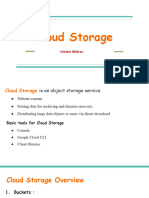WEBVTT
1
00:00:05.990 --> 00:00:09.060
In this video, we're
going to start to
2
00:00:09.060 --> 00:00:11.655
understand what
object storage is,
3
00:00:11.655 --> 00:00:13.995
how data is stored
in object storage,
4
00:00:13.995 --> 00:00:15.240
and how it differs from
5
00:00:15.240 --> 00:00:17.085
the more traditional
storage types,
6
00:00:17.085 --> 00:00:19.260
such as file and block storage.
7
00:00:19.260 --> 00:00:20.850
The first thing to note about
8
00:00:20.850 --> 00:00:22.800
object storage is
that you do not
9
00:00:22.800 --> 00:00:24.945
connect it to a
particular compute node
10
00:00:24.945 --> 00:00:26.355
in order to use it.
11
00:00:26.355 --> 00:00:27.840
Instead, you provision
12
00:00:27.840 --> 00:00:30.120
an object storage
service instance and
13
00:00:30.120 --> 00:00:31.620
�use an API or
14
00:00:31.620 --> 00:00:34.395
application programming
interface to upload,
15
00:00:34.395 --> 00:00:36.585
download, and manage your data.
16
00:00:36.585 --> 00:00:38.400
This means you can directly use
17
00:00:38.400 --> 00:00:40.400
object storage with
anything that you
18
00:00:40.400 --> 00:00:42.095
can call an API and you
19
00:00:42.095 --> 00:00:44.395
don't need an underlying
compute node.
20
00:00:44.395 --> 00:00:45.860
The second thing to note about
21
00:00:45.860 --> 00:00:47.360
object storage is that it's
22
00:00:47.360 --> 00:00:50.630
less expensive than other
Cloud storage options.
23
00:00:50.630 --> 00:00:52.550
Its per gigabyte cost is
24
00:00:52.550 --> 00:00:54.965
typically a couple of
US cents per month,
25
00:00:54.965 --> 00:00:56.165
and in some cases
26
00:00:56.165 --> 00:00:59.165
even less, depending on
the storage tier used--
�27
00:00:59.165 --> 00:01:01.365
more on storage tiers later.
28
00:01:01.365 --> 00:01:04.580
The third and possibly most
important thing to note about
29
00:01:04.580 --> 00:01:07.760
object storage is that
it's effectively infinite.
30
00:01:07.760 --> 00:01:09.545
With file and block storage,
31
00:01:09.545 --> 00:01:11.840
you specify the size
of the storage you
32
00:01:11.840 --> 00:01:14.165
want in gigabytes or terabytes,
33
00:01:14.165 --> 00:01:17.440
and then pay a fee based on
the size you provisioned.
34
00:01:17.440 --> 00:01:20.600
With object storage you just
consume the storage you
35
00:01:20.600 --> 00:01:23.795
need and pay per gigabyte
cost for what you use.
36
00:01:23.795 --> 00:01:25.625
You can keep uploading files
37
00:01:25.625 --> 00:01:27.470
and the storage
will never run out.
38
00:01:27.470 --> 00:01:30.130
When would you use
object storage?
39
00:01:30.130 --> 00:01:32.300
�Well, object storage
is great for
40
00:01:32.300 --> 00:01:35.105
storing large amounts
of unstructured data.
41
00:01:35.105 --> 00:01:38.750
By unstructured, this means
that the data is not stored
42
00:01:38.750 --> 00:01:41.015
in any kind of
hierarchical folder
43
00:01:41.015 --> 00:01:42.730
or directory structure.
44
00:01:42.730 --> 00:01:44.915
Object storage uses buckets,
45
00:01:44.915 --> 00:01:46.700
and objects are stored within
46
00:01:46.700 --> 00:01:49.370
these buckets in a
structurally flat way.
47
00:01:49.370 --> 00:01:51.305
A bucket is a bit like a folder,
48
00:01:51.305 --> 00:01:52.670
in the sense that you can give
49
00:01:52.670 --> 00:01:54.050
them meaningful names and,
50
00:01:54.050 --> 00:01:55.640
of course, have
different buckets
51
00:01:55.640 --> 00:01:57.140
for different object types.
52
00:01:57.140 --> 00:02:00.170
But you cannot place a
�bucket with in a bucket.
53
00:02:00.170 --> 00:02:02.315
When an object is
placed in a bucket,
54
00:02:02.315 --> 00:02:04.260
it also has some metadata.
55
00:02:04.260 --> 00:02:06.605
Data about the data added to it,
56
00:02:06.605 --> 00:02:08.770
such as an object ID.
57
00:02:08.770 --> 00:02:11.210
This metadata helps
applications to
58
00:02:11.210 --> 00:02:13.655
both locate and
access the object,
59
00:02:13.655 --> 00:02:16.130
as well as provide
information on the time
60
00:02:16.130 --> 00:02:18.970
that the data was stored
or last accessed.
61
00:02:18.970 --> 00:02:20.345
When you create a bucket,
62
00:02:20.345 --> 00:02:22.010
you don't need to provide or
63
00:02:22.010 --> 00:02:24.305
define any sizing information.
64
00:02:24.305 --> 00:02:25.550
The bucket will just hold
65
00:02:25.550 --> 00:02:27.470
the data that you
place inside it.
�66
00:02:27.470 --> 00:02:29.750
And the service provider
ensures that there
67
00:02:29.750 --> 00:02:32.255
is sufficient storage
capacity available.
68
00:02:32.255 --> 00:02:35.225
Buckets can hold as little
as a few bytes of data,
69
00:02:35.225 --> 00:02:38.330
right up to multiple petabytes
and you can build up
70
00:02:38.330 --> 00:02:40.070
the amount of data stored as
71
00:02:40.070 --> 00:02:41.975
slowly or quickly as you'd like,
72
00:02:41.975 --> 00:02:43.880
as well as shrink
it back down again.
73
00:02:43.880 --> 00:02:45.500
The service provider also
74
00:02:45.500 --> 00:02:47.540
takes care of
resilience and making
75
00:02:47.540 --> 00:02:49.745
sure that the object
storage solution
76
00:02:49.745 --> 00:02:51.320
is highly available.
77
00:02:51.320 --> 00:02:53.990
Some Cloud providers
offer different types of
78
00:02:53.990 --> 00:02:56.675
�buckets within different
levels of resilience.
79
00:02:56.675 --> 00:02:59.870
For example, they offer
buckets which are resilient,
80
00:02:59.870 --> 00:03:03.095
but the data is only
stored in one data center.
81
00:03:03.095 --> 00:03:06.140
This is a good option where
data needs to reside in
82
00:03:06.140 --> 00:03:08.840
a particular geographical
location or in
83
00:03:08.840 --> 00:03:12.265
situations where high
availability is less of an issue.
84
00:03:12.265 --> 00:03:14.180
They will then offer
buckets which are
85
00:03:14.180 --> 00:03:16.385
highly available across regions
86
00:03:16.385 --> 00:03:18.950
where the data is stored
multiple times in
87
00:03:18.950 --> 00:03:22.145
different data centers or
zones in the same region,
88
00:03:22.145 --> 00:03:24.310
or even in multiple regions.
89
00:03:24.310 --> 00:03:26.465
These options usually cost more,
90
00:03:26.465 --> 00:03:28.640
but they provide both
the highest level of
�91
00:03:28.640 --> 00:03:31.900
resilience as well as
availability for your data.
92
00:03:31.900 --> 00:03:35.390
Object storage has a very
flat storage structure,
93
00:03:35.390 --> 00:03:37.535
which we'll explain
in the next lesson.
94
00:03:37.535 --> 00:03:39.350
This data can be anything from
95
00:03:39.350 --> 00:03:42.455
text files to audio files
and video files from
96
00:03:42.455 --> 00:03:45.230
IoT data to virtual
machine images
97
00:03:45.230 --> 00:03:48.165
from backup files
to data archives.
98
00:03:48.165 --> 00:03:50.900
Pretty much any data
which is static and where
99
00:03:50.900 --> 00:03:53.675
fast read and write
speeds are not necessary,
100
00:03:53.675 --> 00:03:56.200
would make a good fit
for objects storage.
101
00:03:56.200 --> 00:03:58.265
Object storage would, however,
102
00:03:58.265 --> 00:04:01.220
not be suitable for
running operating systems,
�103
00:04:01.220 --> 00:04:03.875
nor applications
such as databases or
104
00:04:03.875 --> 00:04:07.090
anything else where the
contents of the files changes.
105
00:04:07.090 --> 00:04:10.340
To summarize what we have
learned in this lesson,
106
00:04:10.340 --> 00:04:12.230
object storage is used to store
107
00:04:12.230 --> 00:04:15.115
files or objects
which are static.
108
00:04:15.115 --> 00:04:18.395
The data that you can store
using object storage can be
109
00:04:18.395 --> 00:04:21.755
anything from text files
to audio and video files,
110
00:04:21.755 --> 00:04:24.920
from IoT data to
virtual machine images,
111
00:04:24.920 --> 00:04:27.560
from backup files
to data archives.
112
00:04:27.560 --> 00:04:29.990
You cannot run
operating systems or
113
00:04:29.990 --> 00:04:31.580
other applications such as
114
00:04:31.580 --> 00:04:34.100
databases using objects storage.
115
00:04:34.100 --> 00:04:36.125
�Objects are stored in buckets.
116
00:04:36.125 --> 00:04:38.060
You can have multiple
buckets but you
117
00:04:38.060 --> 00:04:40.540
cannot place buckets
within buckets.
118
00:04:40.540 --> 00:04:43.300
You do not need to specify
a size for a bucket.
119
00:04:43.300 --> 00:04:46.520
You can just use as little or
as much space as you need.
120
00:04:46.520 --> 00:04:48.770
Many providers offer
different types of
121
00:04:48.770 --> 00:04:50.880
buckets with different
charges for each.
122
00:04:50.880 --> 00:04:53.495
Some are based on resilience
and availability,
123
00:04:53.495 --> 00:04:55.550
while others are based
on the frequency at
124
00:04:55.550 --> 00:04:58.130
which the objects
inside are accessed.
125
00:04:58.130 --> 00:04:59.360
In the next video,
126
00:04:59.360 --> 00:05:00.570
we'll be diving into
127
00:05:00.570 --> 00:05:05.390
object storage data tiers
and object storage APIs.



























































































